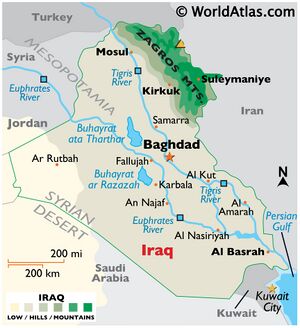Teredon
| Author:Laxman Burdak, IFS (R) |

Teredon was an ancient port city in southern Mesopotamia. It is believed to be in Kuwait near Basra.[1][2][3]
Variants
- Teredon (Anabasis by Arrian,p. 411.)
- Teredon (Ancient Greek: Τερηδών)
- Teredon (romanized: Terēdṓn)
Location
The place could not be localized so far archaeologically, but is believed to be in Kuwait near Basra.[4][5][6]
The Anabasis of Alexander/7b
Arrian[7] gives description of the Euphrates and the Pallacopas....While the triremes were being built for him, and the harbour near Babylon was being excavated, Alexander sailed from Babylon down the Euphrates to what was called the river Pallacopas, which is distant from Babylon about 800 stades.[1] This Pallacopas is not a river rising from springs, but a canal cut from the Euphrates. For that river flowing from the Armenian mountains,[2] proceeds within its banks in the season of winter, because its water is scanty;...
1. About 90 miles. This canal fell into the Persian Gulf at Teredon. No trace of it now remains.
2. The Hebrew name for Armenia is Ararat (2 Kings xix. 37; Isa. xxxYii. 38; Jer. li. 27).
Mention by Pliny
Pliny[8] mentions Arabia....We next come to a city situate on the banks of the Pasitigris, Fora by name, and subject to the king of Charax: to this place people resort on their road from Petra, and sail thence to Charax, twelve miles distant, with the tide. If you are proceeding by water from the Parthian territories, you come to a village known as Teredon; and below the confluence of the Euphrates and Tigris, you have the Chaldæi dwelling on the left side of the river, and the Nomadic tribes of the Scenitæ on the right.
History
The place is mentioned several times by ancient writers. It is said to have been founded by Nebuchadnezzar II, who built a palace with hanging gardens here.[9] Teredon is said to have been located at the mouth of the Euphrates in the Persian Gulf and was an important port city in the Empire of the Characene.
References
- ↑ Andreas P. Parpas (2016). The Hellenistic Gulf: Greek Naval Presence in South Mesopotamia and the Gulf (324-64 B.C.). p. 79.
- ↑ "Travel - Peter Harrington London" (PDF). Peter Harrington. 2017. p. 4.
- ↑ J. Theodore Bent (January 1890). "The Bahrein Islands, in the Persian Gulf". Proceedings of the Royal Geographical Society and Monthly Record of Geography. JSTOR. 12 (1): 13.
- ↑ Andreas P. Parpas (2016). The Hellenistic Gulf: Greek Naval Presence in South Mesopotamia and the Gulf (324-64 B.C.). p. 79.
- ↑ "Travel - Peter Harrington London" (PDF). Peter Harrington. 2017. p. 4.
- ↑ J. Theodore Bent (January 1890). "The Bahrein Islands, in the Persian Gulf". Proceedings of the Royal Geographical Society and Monthly Record of Geography. JSTOR. 12 (1): 13.
- ↑ The Anabasis of Alexander/7b, Ch.21, p.411
- ↑ Natural History by Pliny Book VI/Chapter 32
- ↑ nach Eusebius, Chronik, 1, 4, siehe Übersetzung

